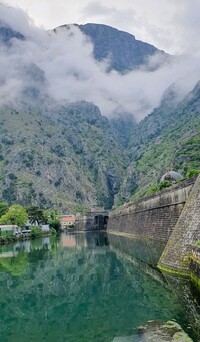Photo. Some glimpse of the Walls of Kotor with Kampana tower. © Travel Explorations.
The Walls of Kotor are a magnificent historical fortification system surrounding the old town of Kotor. Mainly built between the 4th and 14th centuries. Here I wandered along them to see the mountainside St. John’s Fortress and spectacular panoramas over Kotor and the Bay of Kotor beyond.
By exploring the Walls of Kotor, I could get insight in the rich history and breathtaking scenery of one of Montenegro’s most iconic landmarks. Wandering the walls I tried to imagine how the lives of those who built and defended these fortifications. The walls provide a glimpse into Kotor’s strategic importance through history, including its role in trade, defense, and cultural exchange in the Adriatic region.
The construction of the walls began in the 9th century and continued through the Venetian period until the 19th century. They were built to protect the town from invasions and attacks.
The walls are a blend of medieval, Renaissance, and baroque architectural styles, reflecting the various periods of construction and influence.
The walls stretch approximately 4.5 kilometers (2.8 miles) around the old town, rising steeply up the slopes of Mount Lovćen. They include towers, bastions, gates, and a fortress. In some places, the walls reach a height of up to 20 meters (65 feet) and are about 15 meters (50 feet) thick. The three main gates to the old town are the Sea Gate (west), River Gate (north), and Gurdic Gate (south).
By taking a look up hillside, I could observe St. John’s Fortress (San Giovanni Fortress). It sits at the top of the hill, approximately 280 meters (920 feet) above sea level. The climb involves over 1,300 steps but rewards hikers with panoramic views of Kotor Bay and the surrounding mountains.
About halfway up the climb to the fortress, visitors will encounter the small and picturesque St. John’s Church, offering a rest point and a beautiful view. And there is a church located along the climbing path, which is a significant historical and religious site. It`s caled Church of Our Lady of Remedy and was built in the 15th century.
The fortifications of Kotor are an integrated historical fortification system that protected the medieval town of Kotor containing ramparts, towers, citadels, gates, bastions, forts, cisterns, a castle, and ancillary buildings and structures. They incorporate military architecture of Illyria, the Byzantine Empire, Venice, and Austria.
Together with the old town and its natural surroundings the fortifications were inscribed in the list of World Heritage Sites in 1979 labelled Natural and Culturo-Historical Region of Kotor and represent the only such site of cultural significance in Montenegro.
The fortified city of Kotor was also included in UNESCO's World Heritage Site list as part of Venetian Works of Defence between 15th and 17th centuries: Stato da Terra – western Stato da Mar in 2017.
After exploring the walls, I spend time wandering through the narrow streets of the old town. There I could observe St. Tryphon’s Cathedral, the Maritime Museum, and numerous charming squares and churches.
Stein Morten Lund, May 2024
Additional information
Read more about the Walls of Kotor on Wikipedia.












